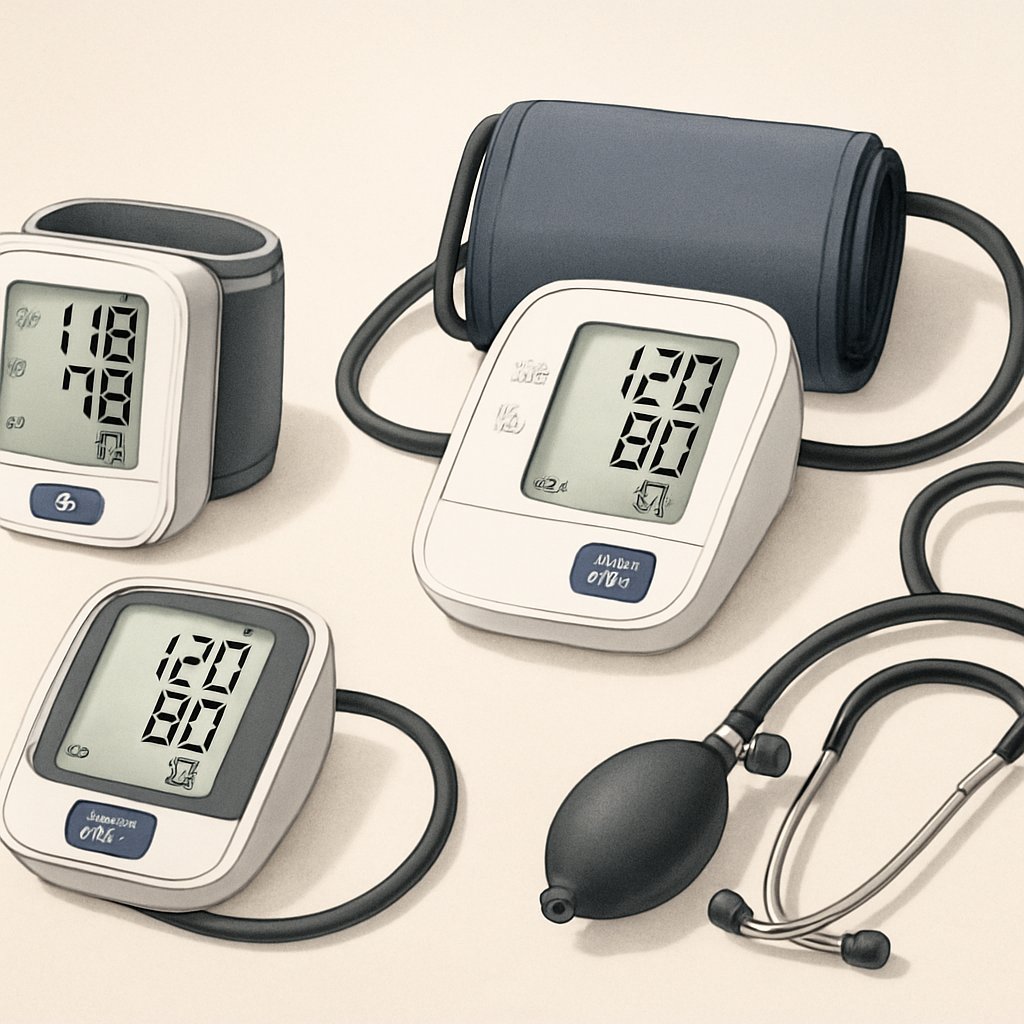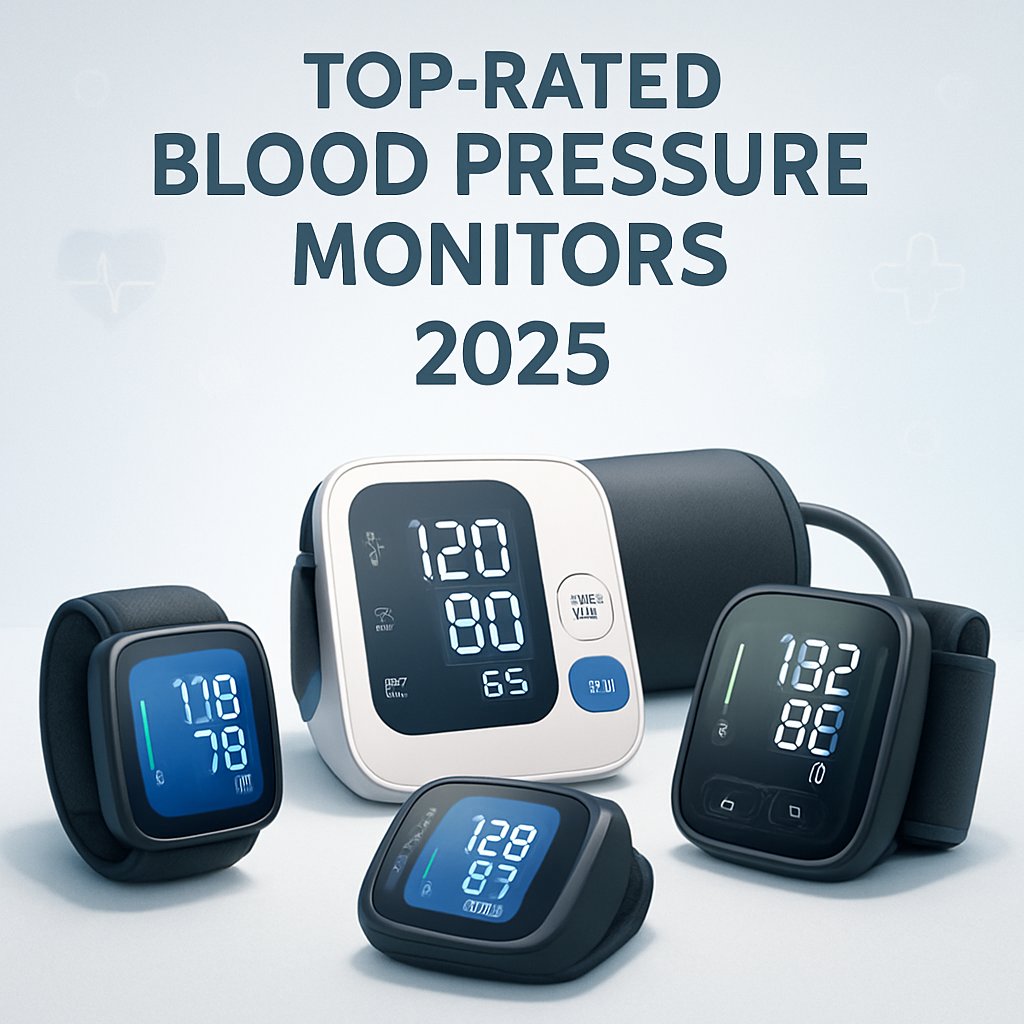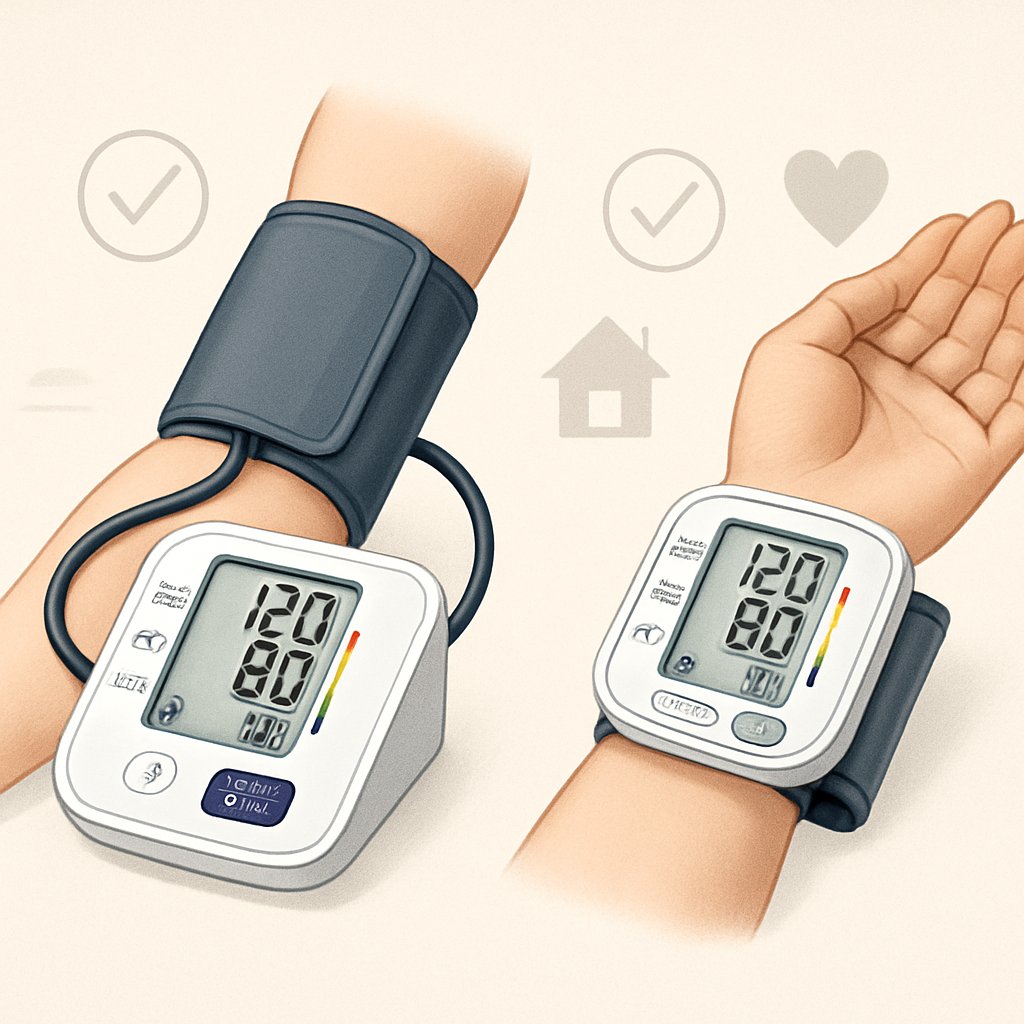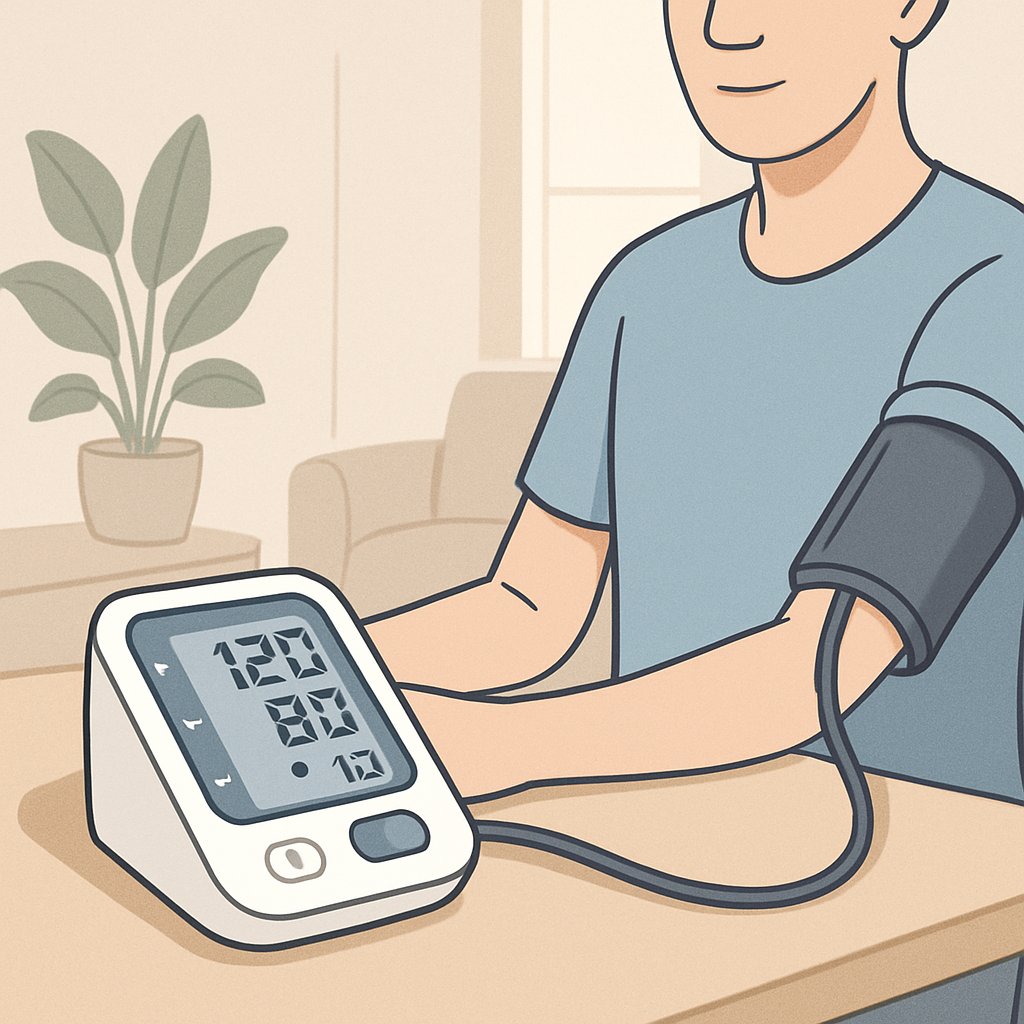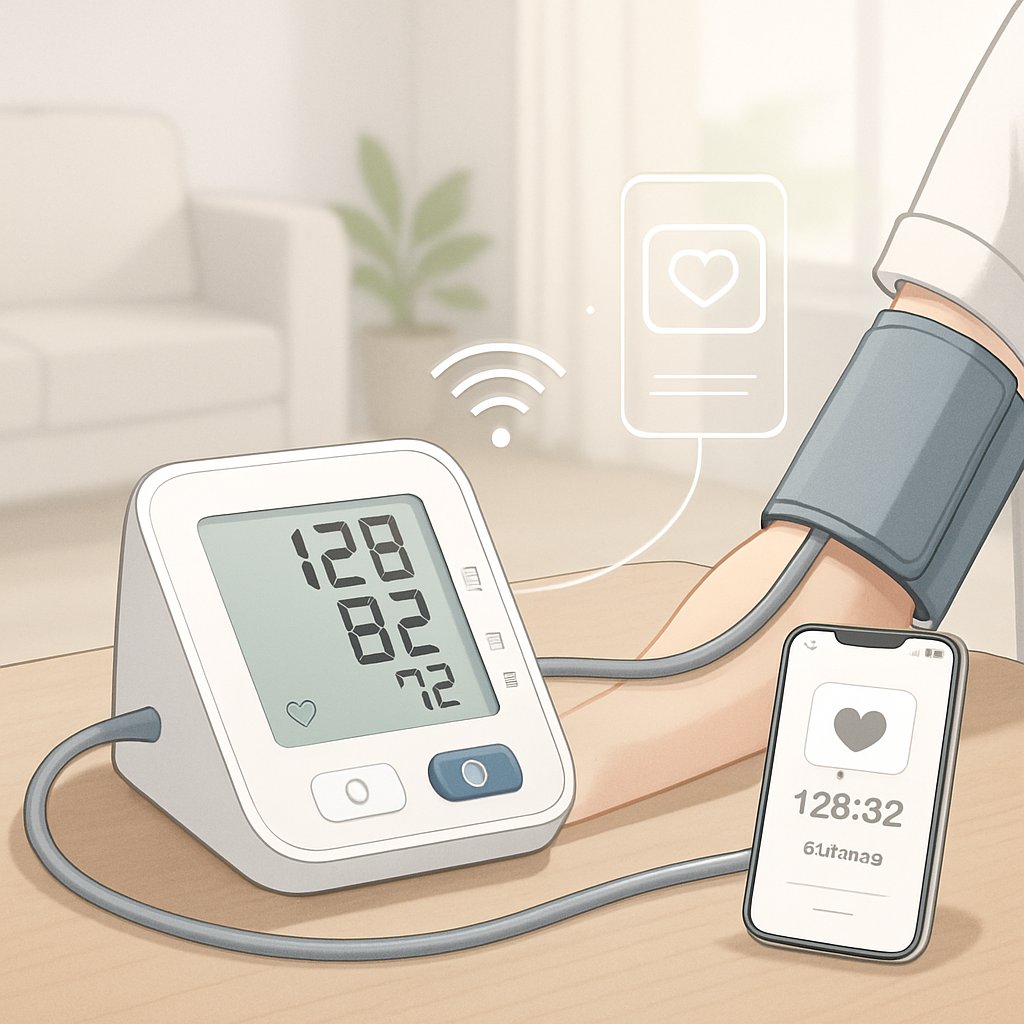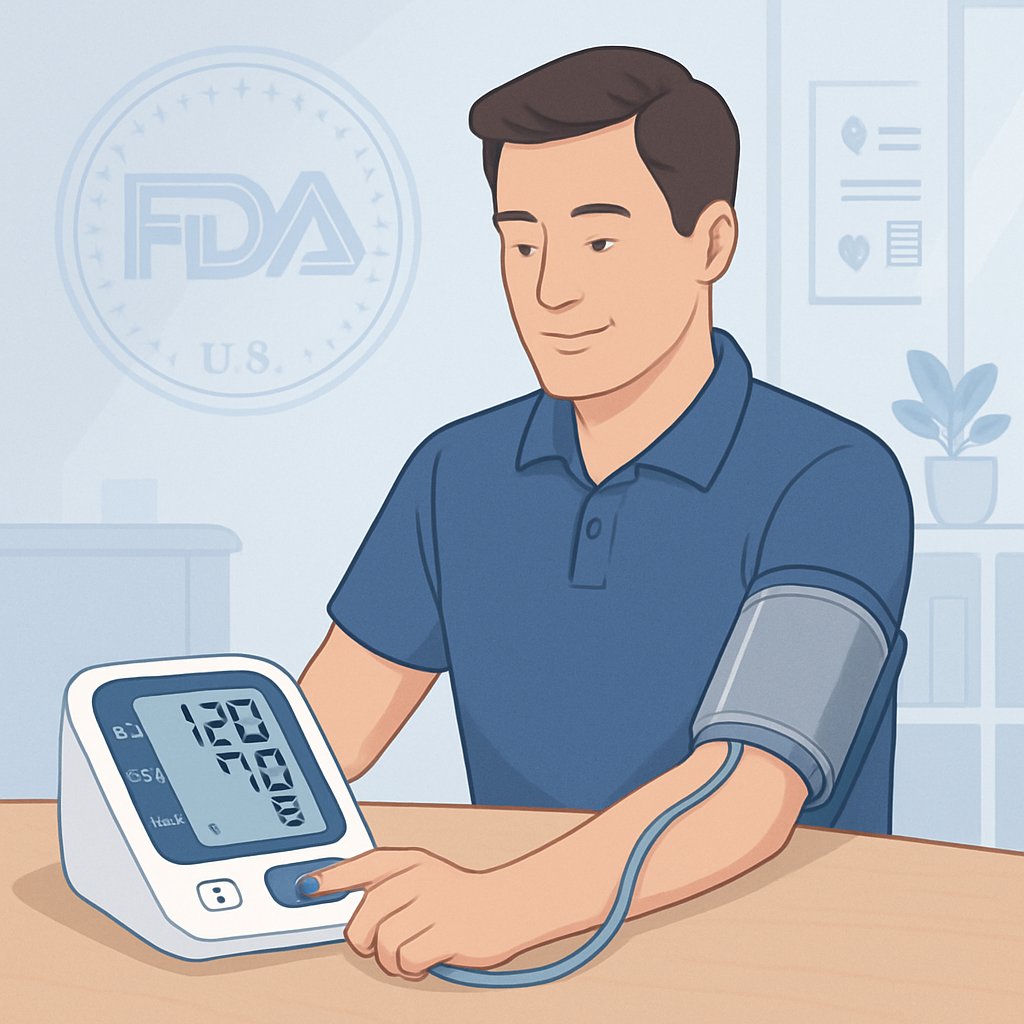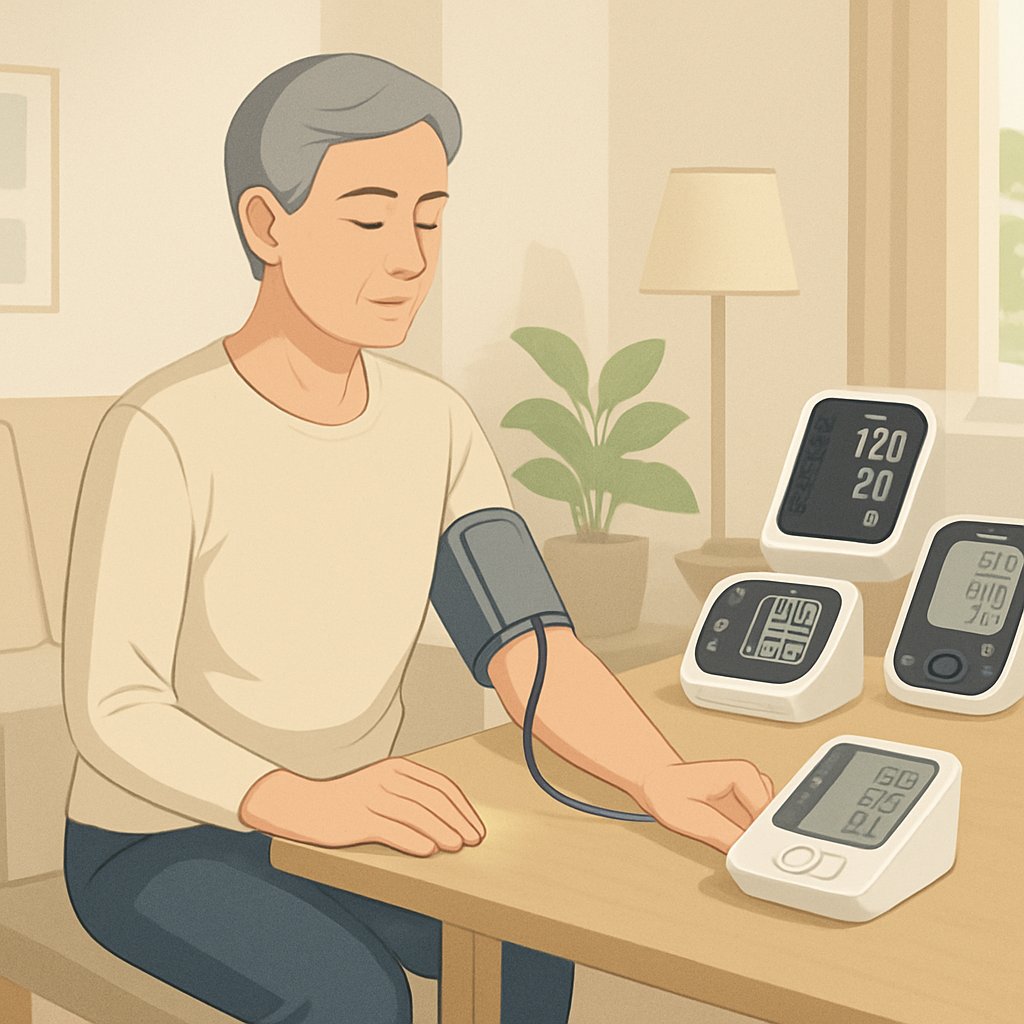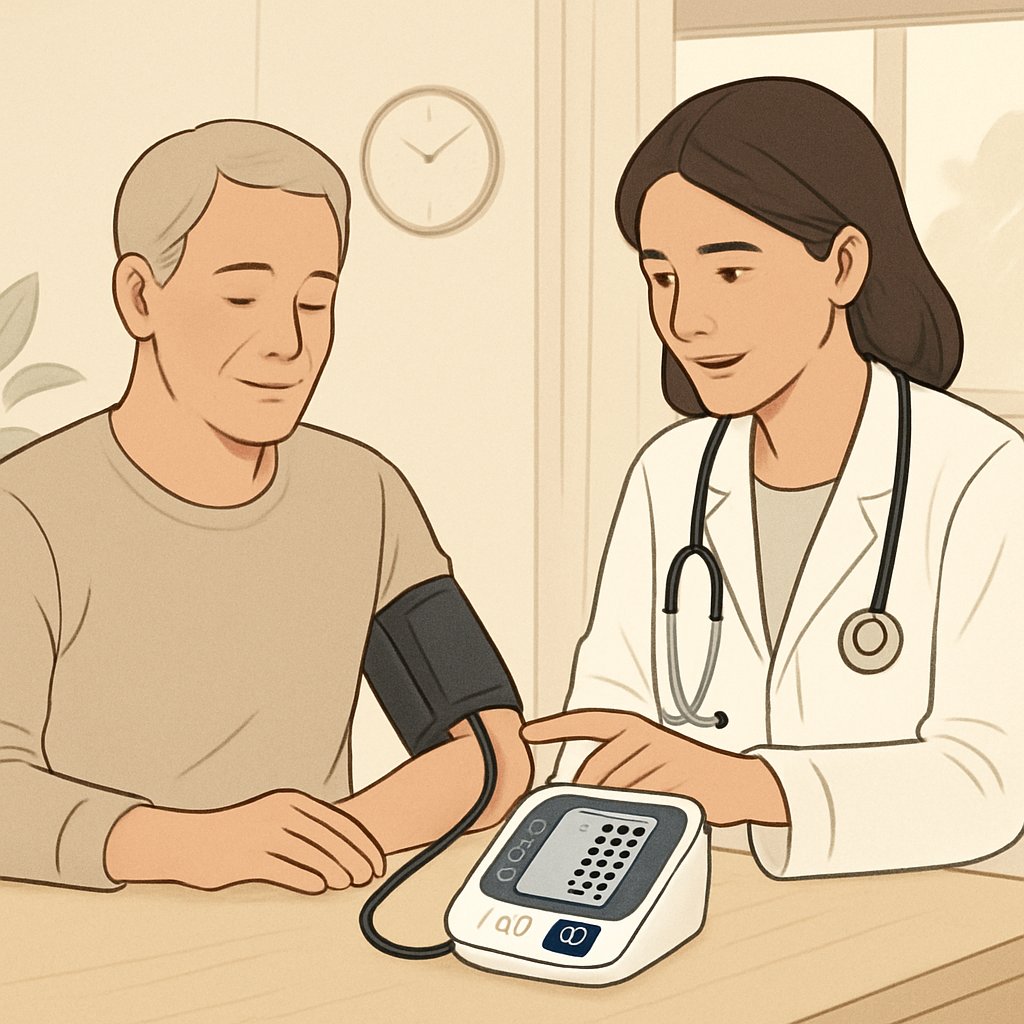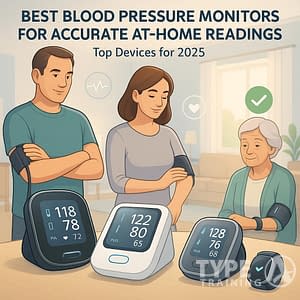Keeping track of your
The best

When you’re shopping for a monitor, you’ll see everything from basic arm cuffs to devices that sync with your phone. Most doctors say arm monitors beat wrist ones for accuracy, so that’s worth noting.
Popular posts:
Always check that your device’s been through clinical testing and has FDA clearance. That way, you know the numbers you see at home actually mean something.
Studies suggest that monitoring your own blood pressure can help you control it, especially in the early months. If you’re worried about hypertension or just want to keep tabs on your heart, a good monitor is a smart buy.
Key Takeaways
- Checking your
blood pressure at home regularly gives you useful info and can help keep it in check over time. - Arm cuff monitors are usually more accurate than wrist types and should have clinical validation or FDA clearance.
- The top
blood pressure monitors balance accuracy with handy features like big displays, memory storage, and app syncing.
Why Accurate At-Home Blood Pressure Monitoring Matters

Taking your
Risks of Inaccurate Blood Pressure Readings
If you use a monitor that’s not validated or calibrated right, you could face some big problems. Wrong readings can mean the wrong meds or unnecessary treatments.
If your monitor always gives low numbers, you might miss high
On the flip side, if it reads too high, you could end up taking meds you don’t need. That brings its own issues—dizziness, fatigue, or even dangerously low
Common causes of inaccurate readings:
- Poor cuff placement or wrong cuff size
- Moving around during measurement
- Sitting in the wrong position
- Using wrist or finger monitors (not really recommended)
- Uncalibrated or cheap devices
Benefits of Self-Monitoring for Hypertension
When you check your
Self-monitoring puts you in the driver’s seat. You can actually see how things like diet, exercise, or stress show up in your numbers.
Tracking your readings gives you a sense of your own patterns.
Home monitoring can help cut down on trips to the doctor, saving you time and money. Plus, your doctor can fine-tune your meds based on what’s really happening day to day.
Role in Preventing Heart Attacks and Strokes
Keeping an eye on your
Spotting rising
Critical prevention benefits:
- Spotting dangerous spikes
- Seeing if your meds are working
- Noticing patterns that need a doctor’s look
- Encouraging lifestyle changes before things get serious
When you track your numbers, you’re more likely to stick with your treatment. Honestly, seeing improvement can be a real motivator to keep up healthy habits.
Key Features of the Best Blood Pressure Monitors
Picking a
Getting the right combo means you’ll actually use it—and trust the numbers enough to share them with your doctor.
Clinical Validation and Accuracy
Accuracy really is the dealbreaker here. Go for monitors that are clinically validated by groups like AAMI, ESH, or ISO.
These certifications mean the device has been tested against professional equipment and passed. The Omron Platinum Blood Pressure Monitor is a standout this year for accuracy.
FDA-approved monitors give you extra peace of mind. Many top picks now offer advanced detection features like arrhythmia alerts, movement detection, and reminders if you mess up the cuff placement.
- Arrhythmia detection
- Movement detection
- Cuff placement error alerts
These smart systems help you avoid the mistakes that mess up your results. For the most reliable numbers, look for monitors that average multiple readings.
Ease of Use and User-Friendly Design
A user-friendly design matters more than you’d think. The cuff should be easy to put on by yourself, without feeling like a puzzle.
One-button operation is a lifesaver, especially for older folks or anyone with hand issues. Most newer monitors inflate and deflate automatically, so you don’t have to guess what’s going on.
Clear instructions make the whole experience less stressful. Look for simple interfaces and as few buttons as possible—it just makes life easier.
Some monitors even talk you through the process, which is surprisingly handy. And don’t forget cuff size; it actually matters for getting real results.
Display and Data Storage Options
An easy-to-read display with big numbers saves you from squinting. Many models now use color codes based on American Heart Association guidelines, so you know at a glance if you’re in the green or not.
Most monitors store your readings, which is super helpful:
- Basic models: 30-60 readings
- Advanced models: 100+ readings with time and date
- Premium: Multiple user profiles (great for families)
Some monitors even sync with your phone via Bluetooth, letting you store unlimited data. These apps can build charts and reports, making it way easier to track trends or show your doctor what’s going on.
Portability and Battery Life
If you travel a lot or just want to check your
Battery life matters, too. Most newer devices have rechargeable lithium-ion batteries that last for months, so you’re not always hunting for AAs.
For travel, consider:
- Weight (under 1 pound is perfect)
- Size (small enough for a purse or backpack)
- Does it come with a case?
- USB charging is a nice bonus
Consumer Reports found that the best portable models don’t sacrifice accuracy for convenience, which is honestly a relief for people always on the go.
Types of At-Home Blood Pressure Monitors
If you want to check your blood pressure at home, you’ve got a few choices. The type you pick affects how accurate your results are, how easy it is to use, and what extra features you get.
Upper Arm Blood Pressure Monitors
Upper arm monitors are hands-down the most accurate for home use. The American Heart Association actually recommends automatic, cuff-style monitors for the best results.
These use an inflatable cuff that wraps around your upper arm, then measures pressure as it inflates and slowly deflates. It’s all automatic, so you don’t have to do any guesswork.
Why go with upper arm monitors?
- They’re just more accurate
- Clinically validated by medical groups
- Consistent readings if you use them right
Most good models come with different cuff sizes. Make sure you pick one that fits your arm—too big or too small can throw off your numbers. Many Omron models are certified for accuracy and let you choose the right cuff size.
Wrist Blood Pressure Monitors
Wrist
They’re easier to take with you, but usually, wrist monitors aren’t as accurate as upper arm models. To get a reliable reading, you need to keep your wrist at heart level during measurement—otherwise, the numbers can be off.
Benefits of wrist monitors include:
- Compact size for travel and storage
- Comfort for users with larger arms
- Easier application without assistance
For accurate results with a wrist monitor:
- Sit with your back supported
- Rest your arm on a flat surface
- Keep your wrist at heart level
- Try to measure at the same time each day
Smart Blood Pressure Monitors
Smart
Consumer Reports rates several smart monitors among their top picks for 2025. The readings automatically show up in an app, making it easy to spot trends.
Features you’ll often find in smart monitors:
- Automatic data storage of readings
- Trend analysis to identify patterns
- Sharing capabilities with healthcare providers
- Medication reminders and health tips
Most smart monitors use upper arm cuffs for better accuracy and add the perks of wireless connectivity. Some models let you set up multiple user profiles, which is handy for families keeping tabs on everyone’s
Top-Rated Blood Pressure Monitors in 2025
Several
Best Overall Blood Pressure Monitor
The Omron Platinum BP5450 keeps landing at the top of the list for at-home monitoring this year. It stores up to 100 readings for two users and calculates your morning average, which doctors often say is the most important number.
The Platinum uses TruRead™ technology to take three consecutive readings and average them for better accuracy. Its large display compares your results to normal
Key features include:
- Upper arm cuff design (most accurate type)
- Irregular heartbeat detection
- Multi-user capability
- Bluetooth connectivity to the Omron app
Most Affordable Blood Pressure Monitor
The Omron 3 Series delivers solid accuracy at a price that won’t break the bank. Even though it’s budget-friendly, it still meets the clinical standards Omron is known for.
This straightforward monitor stores 14 readings and comes with a standard cuff that fits arms 9-17 inches around. The display clearly shows your systolic, diastolic, and pulse numbers, plus a hypertension indicator.
What you get for the price:
- One-button operation
- Clear, easy-to-read display
- Irregular heartbeat detection
- FDA-approved accuracy
Best Wireless and Bluetooth Models
The Withings BPM Connect and Omron Evolv are leading the wireless pack with modern looks and smart connectivity.
The Withings BPM Connect keeps things simple with its minimalist design and Wi-Fi and Bluetooth support. Your readings sync automatically to the Health Mate app, which lays out your
The Omron Evolv—no tubes, no separate parts—offers a true all-in-one experience with:
- One-piece design (no tubes or separate components)
- Silent inflation
- Unlimited storage through the Omron Connect app
- Compatibility with both iOS and Android devices
Both models make it easy to share your results with your doctor, which is a big plus if you want to keep them in the loop. If convenience and long-term tracking matter to you, these wireless options are worth a look.
Best Blood Pressure Monitors for Accurate Home Readings
Choosing a home
Advantages of Arm Monitors
Arm monitors are generally more accurate for home readings. They measure
These devices usually offer:
- Larger, easier-to-read displays
- More reliable readings when properly positioned
- Better clinical validation
- Greater acceptance by medical professionals
Arm monitors work best when you’re sitting down with your arm supported at heart level. They’re a bit bulkier than wrist models, but the extra accuracy is usually worth it if reliable readings are your priority.
Pros and Cons of Wrist Monitors
Wrist
But there are downsides:
- Can give falsely high readings if not positioned exactly right
- Need to be placed directly over the wrist
- Require your wrist to stay at heart level during measurement
To get a decent reading, you have to position the monitor carefully—right over your wrist, arm supported, wrist at heart level. Even a small mistake can throw off the results.
Most doctors still recommend arm monitors unless you have a specific reason to go with a wrist model.
Important Considerations When Choosing a Blood Pressure Monitor
Picking the right
Cuff Size and Comfort
Cuff size is critical for accurate readings. The wrong size can mess up your results—too small, and your numbers might look too high; too big, and they could read low.
Most adults need a medium cuff, but if your upper arm is over 13 inches around, you might need a large or extra-large cuff. It’s worth measuring your arm at its widest point before you buy.
Look for cuffs made with soft, breathable materials and secure closures. Pre-formed cuffs are easier to put on correctly, and they’re a lot more comfortable for regular checks.
Some monitors offer universal cuffs that fit a range of sizes, but dedicated sizing usually gives you better accuracy and comfort.
Irregular Heartbeat Detection
A lot of
If you have or are at risk for atrial fibrillation or other arrhythmias, this is especially helpful. The monitor will show a special icon if it picks up something irregular.
Keep in mind, this feature doesn’t diagnose anything—it’s just a heads up that you might want to check in with your doctor. If you keep seeing irregular heartbeat alerts, it’s time to reach out to a healthcare provider.
Some advanced monitors store info about irregular rhythms alongside your
Multi-User Functionality
If more than one person at home needs to track
Ideally, the device should let you switch profiles easily—clear buttons help. Each profile should save at least 60 readings so you can spot trends over time.
Some monitors pair with smartphone apps, letting each user keep their own profile. This makes it simpler to share results with different doctors if needed.
Advanced multi-user models may even offer personalized analysis for each person, highlighting trends and averages over days or weeks.
Connectivity and App Integration
Modern
Bluetooth and Wireless Syncing
Most accurate blood pressure monitors in 2025 have Bluetooth built in. This lets your monitor send readings straight to your phone—no need to jot down numbers by hand.
Pairing is usually simple:
- Turn Bluetooth on for both devices
- Open the monitor’s companion app
- Follow the app’s prompts to pair
- Confirm the connection when asked
Most models sync wirelessly after each reading. The Omron 10 Series Wireless stands out for keeping your readings safe even if your phone isn’t nearby, then syncing everything up next time you connect.
Tracking Health Metrics with Apps
Companion apps turn simple readings into actionable health insights. Most
Key metrics typically monitored include:
- Blood pressure readings (systolic/diastolic)
- Heart rate
- Irregular heartbeat detection
- Morning and evening averages
- Weekly and monthly trends
The Omron app displays data in clear graphs and charts. You can set reminders for readings and medications right in most apps.
Some advanced apps even connect your
Data Sharing with Healthcare Providers
Sharing your
Common sharing methods include:
- PDF reports via email
- Direct integration with patient portals
- QR codes for quick scanning during appointments
- Printed reports with trend analysis
This is especially helpful for telehealth visits. Your doctor can review your
Home monitoring with data sharing gives your healthcare team a more complete picture of your cardiovascular health. Most systems use encrypted connections to keep your information safe.
Clinical Validation, FDA Clearance, and Reliability
When you’re picking a
Understanding Clinical Validation Standards
Clinical validation means experts have tested the
Validated devices are tested on different groups of people and must deliver readings within a tight margin of error. The Validate BP database is a free tool to help you find monitors that have passed these tests.
Look for devices that mention specific validation protocols on their packaging or in the manual. A good validated monitor should stay accurate over time and for different users.
Not every monitor on the shelf goes through this level of scrutiny. That’s why it’s smart to check for validation before you buy.
Importance of FDA-Approved and Cleared Devices
The FDA (Food and Drug Administration) oversees
FDA clearance means the device is considered safe and is similar to others already on the market. That doesn’t always mean it’s clinically accurate.
For the best reliability, pick devices that are both FDA-cleared and clinically validated. Products like the Garmin Index BPM check both boxes.
Don’t just trust marketing claims. Make sure the monitor has passed real clinical testing, not just the minimum safety checks.
Role of Medical Associations and Guidelines
Major medical associations set the standards for
The American Heart Association and World Health Organization update their recommendations on monitoring techniques and equipment selection. These guidelines change as new research comes out.
Your doctor might recommend certain monitors based on these guidelines. Some associations even keep lists of devices that meet their accuracy standards.
Using a monitor that follows these expert recommendations means you’re working with equipment your doctor trusts. If you’re making health decisions based on your readings, this really matters.
Double-check that your chosen monitor matches the latest guidelines from these trusted sources.
Using a Blood Pressure Monitor Correctly
Getting accurate blood pressure readings at home takes a bit of technique and consistency. The right steps make sure your numbers actually reflect your
Proper Positioning and Cuff Placement
Sit in a chair with your back supported and feet flat on the floor. Rest for at least five minutes before you start.
Support your arm at heart level on a table or armrest. The blood pressure cuff should go directly on bare skin, not over clothing.
Position the cuff about one inch above your elbow crease. The tubing should run down the center of your arm.
Pick the right cuff size for your arm. Using the wrong size throws off your results. Most at-home blood pressure monitors come with a medium cuff, but you can get bigger or smaller ones if you need.
Secure the cuff so it’s snug but not painfully tight—you should be able to slip a finger between the cuff and your arm.
Tips for Accurate Home Measurements
Take your readings at the same time each day, usually morning and evening. Skip caffeine, exercise, and smoking for at least 30 minutes before measuring.
Stay quiet and relaxed during the measurement. Any movement or tension can mess with your numbers.
Record both systolic and diastolic numbers with the date and time. Most digital monitors will save this for you automatically.
Take two or three readings about a minute apart, then average them for the most accurate result.
Consider a validated device that’s been tested for accuracy by a reputable group.
Common Mistakes and How to Avoid Them
It’s easy to mess up the arm position. Your arm should always be at heart level—too high or too low will skew the results.
Measuring right after exercise or when you’re stressed can raise your
Checking your
Don’t take measurements over clothing or with a poorly placed cuff. Always use bare skin and double-check the placement.
Don’t round your numbers or skip “bad” readings. Share all your results with your healthcare provider for the best advice.
When to Consult Your Healthcare Provider
Home monitoring is valuable, but sometimes your
Recognizing Irregular Results
Watch for consistent readings above 130/80 mmHg, which could signal hypertension. Call your healthcare provider right away if you see:
- Sudden spikes above 180/120 mmHg (hypertensive crisis)
- Big swings between readings
- Consistently low readings (below 90/60 mmHg)
Serious warning signs that need immediate medical attention:
- Severe headache with high
blood pressure - Chest pain or shortness of breath
- Dizziness, confusion, or blurred vision
- Nausea and vomiting with elevated readings
Your monitor might show irregular heartbeat alerts, which can signal things like atrial fibrillation or other arrhythmias. Don’t try to diagnose yourself—get checked out by a professional.
Managing High Blood Pressure at Home
Between appointments, monitor your blood pressure regularly and keep a detailed log. Record:
| Information to Track | Why It Matters |
|---|---|
| Date and time | Identifies patterns |
| Systolic/diastolic readings | Shows treatment effectiveness |
| Heart rate | Indicates cardiac function |
| Symptoms felt | Correlates feelings with numbers |
| Medications taken | Tracks medication effects |
If your readings stay above your target range even with medication, reach out to your doctor. They might need to adjust your plan.
Don’t stop or change your medications without talking to your healthcare provider, even if your readings look better. Home monitoring can also help spot white coat syndrome (when your
Monitoring for Heart Conditions
Modern
- Tachycardia (fast heart rate over 100 bpm)
- Bradycardia (slow heart rate under 60 bpm)
- Irregular rhythm
- Skipped or extra beats
These need a doctor’s review, especially if you’re also feeling tired, short of breath, or lightheaded.
Many advanced monitors in 2025 can spot subtle rhythm changes that might hint at heart issues. Keeping track helps you and your doctor figure out what’s normal for your sinus rhythm.
Bring your records to appointments so your provider has the full picture when making decisions about your heart health.
Frequently Asked Questions
People often have specific questions about home
What are the top-rated blood pressure monitors for home use according to consumer reports?
According to Consumer Reports’ 2025 ratings, a few models really stand out for home use. The Omron Platinum BP5450 keeps showing up as a favorite for both accuracy and ease of use.
Other top picks include the Greater Goods
Which blood pressure monitors have received FDA approval?
Most well-known
FDA clearance means someone actually tested the device for safety and accuracy. Check the product box or manual for the FDA clearance statement before buying—just to be sure.
How does the Omron Platinum compare to other high-accuracy blood pressure monitors?
The Omron Platinum BP5450 tends to outperform a lot of its competitors in accuracy tests. It lets you store readings for multiple users and averages out results, which is pretty handy.
Compared to the A&D Medical UA-767F, the Omron offers more ways to connect and a cleaner, more intuitive interface. It also gives you morning averages, which can help you notice
Can wrist blood pressure monitors match the accuracy of upper arm models?
Wrist
The way you position your wrist compared to your heart really changes the reading. Even a small shift in wrist height can throw things off.
Doctors almost always recommend upper arm monitors for the most consistent and trustworthy results.
What features should be considered when purchasing a blood pressure monitor for at-home readings?
When picking out a monitor, look at cuff size first. The right fit matters a lot for accuracy, and most monitors offer a few cuff options.
Memory storage helps you keep track of your numbers over time. If more than one person will use it, multi-user features are a plus.
Large, clear displays make daily checks less of a hassle. Some newer models can sync with your phone, which is a nice bonus for staying organized.
How do professional reviews rate the Vitaltrack Pro blood pressure monitor?
The Vitaltrack Pro gets mixed reviews from professionals. Some appreciate its compact design and long battery life.
But a few medical pros aren’t sure about the consistency of its readings. When you stack it up against industry leaders like the Omron models, it falls short on features.
For example, it doesn’t offer irregular heartbeat detection or deep data analysis. Still, it’s affordable and simple, which might be enough for basic monitoring.


